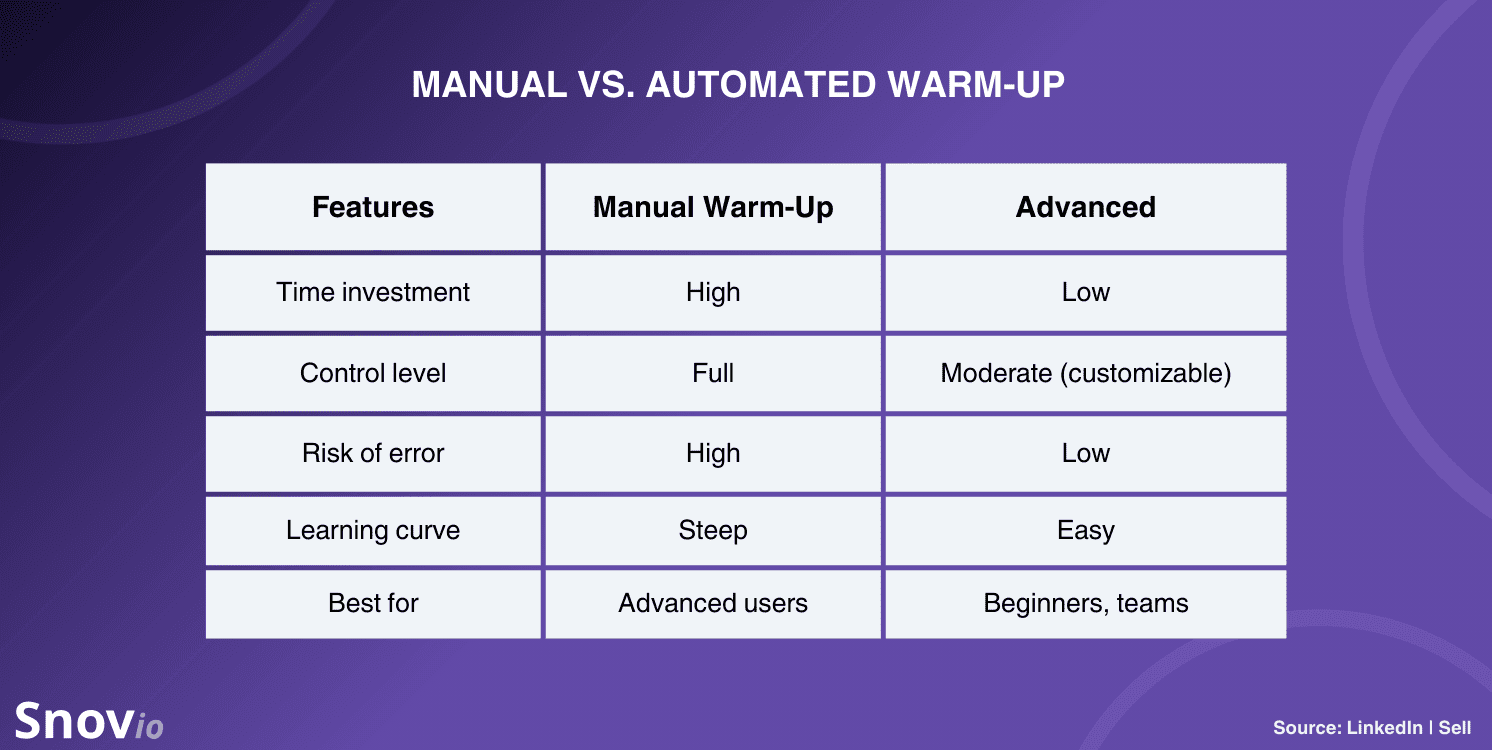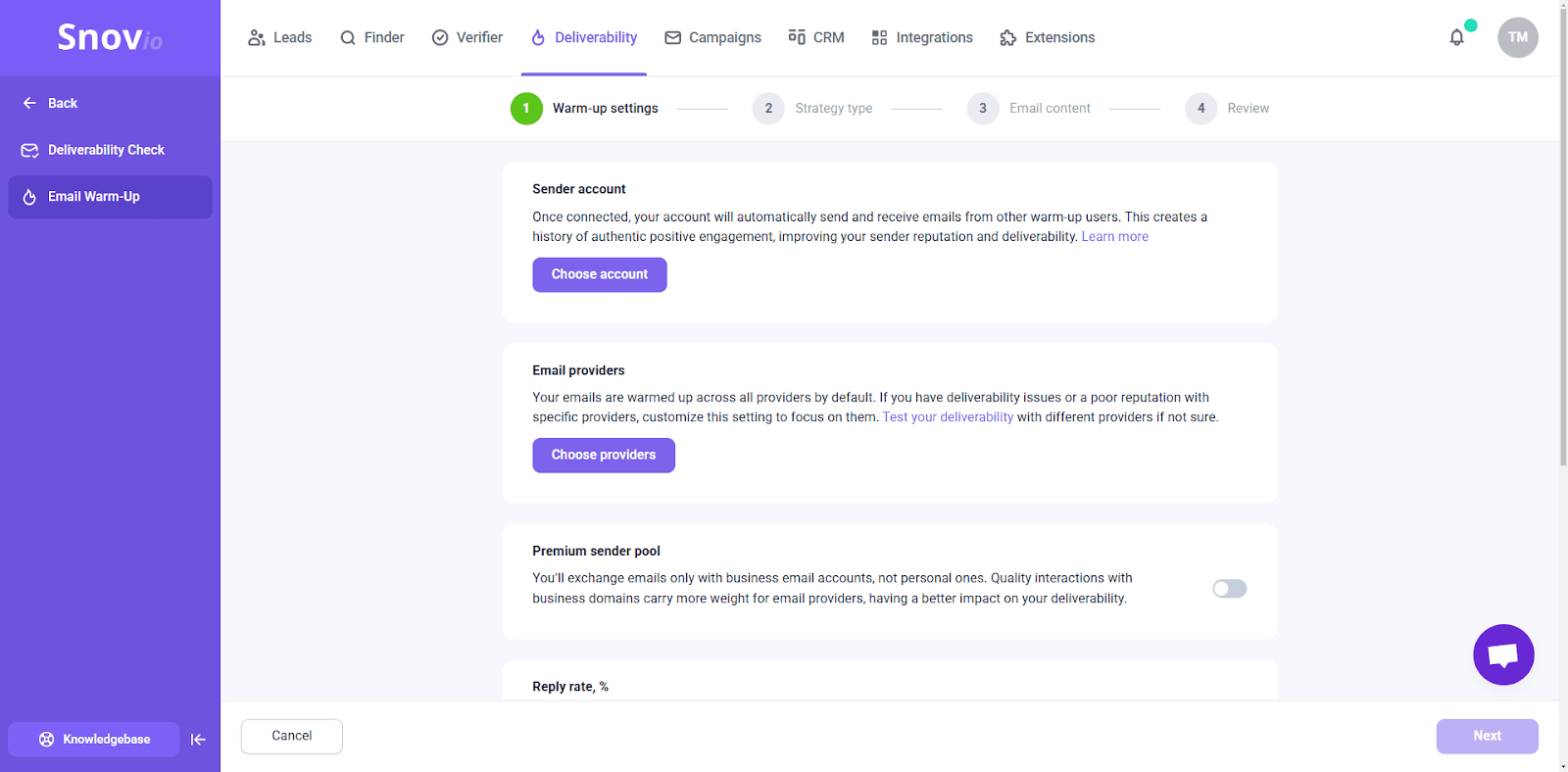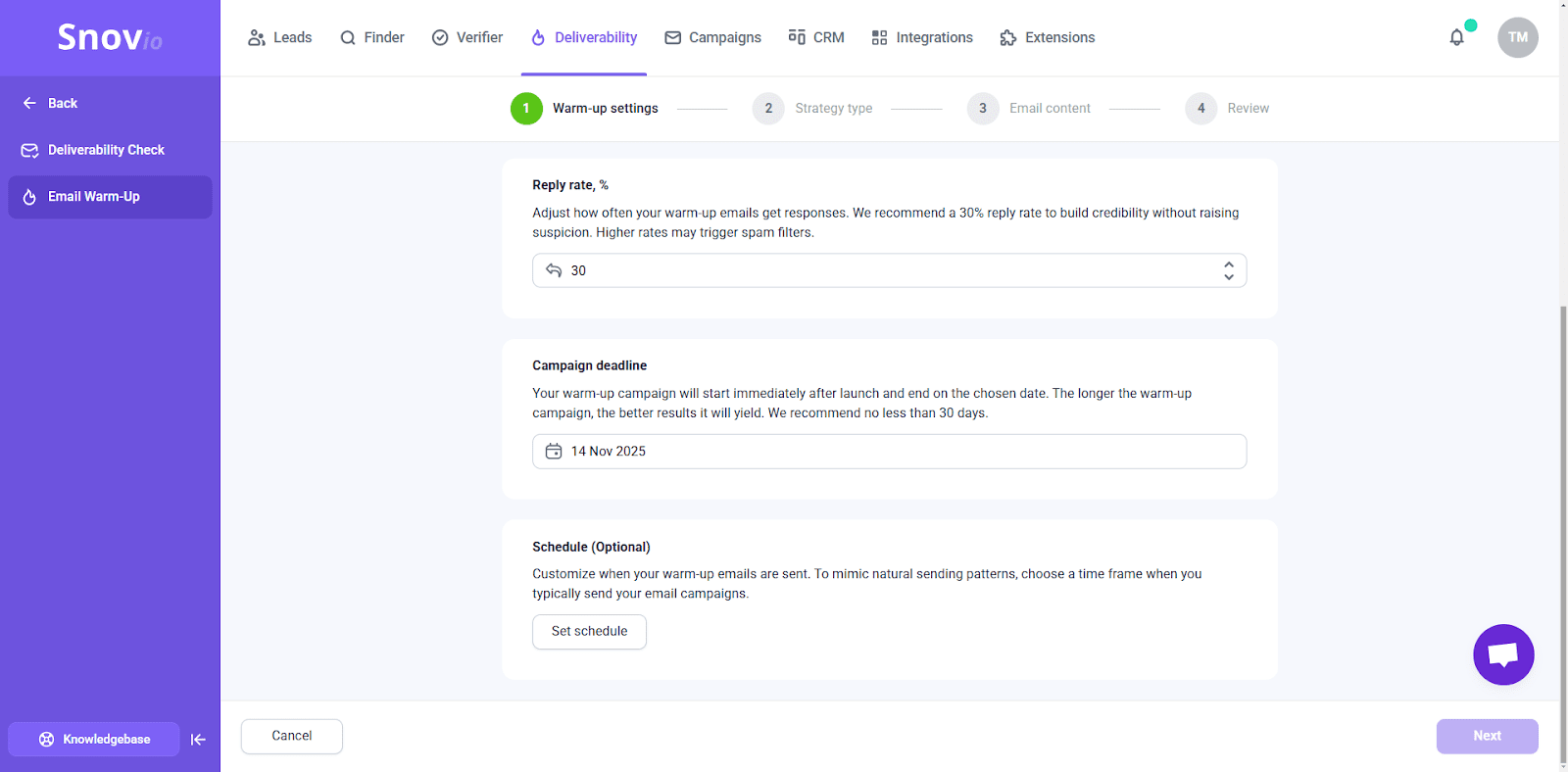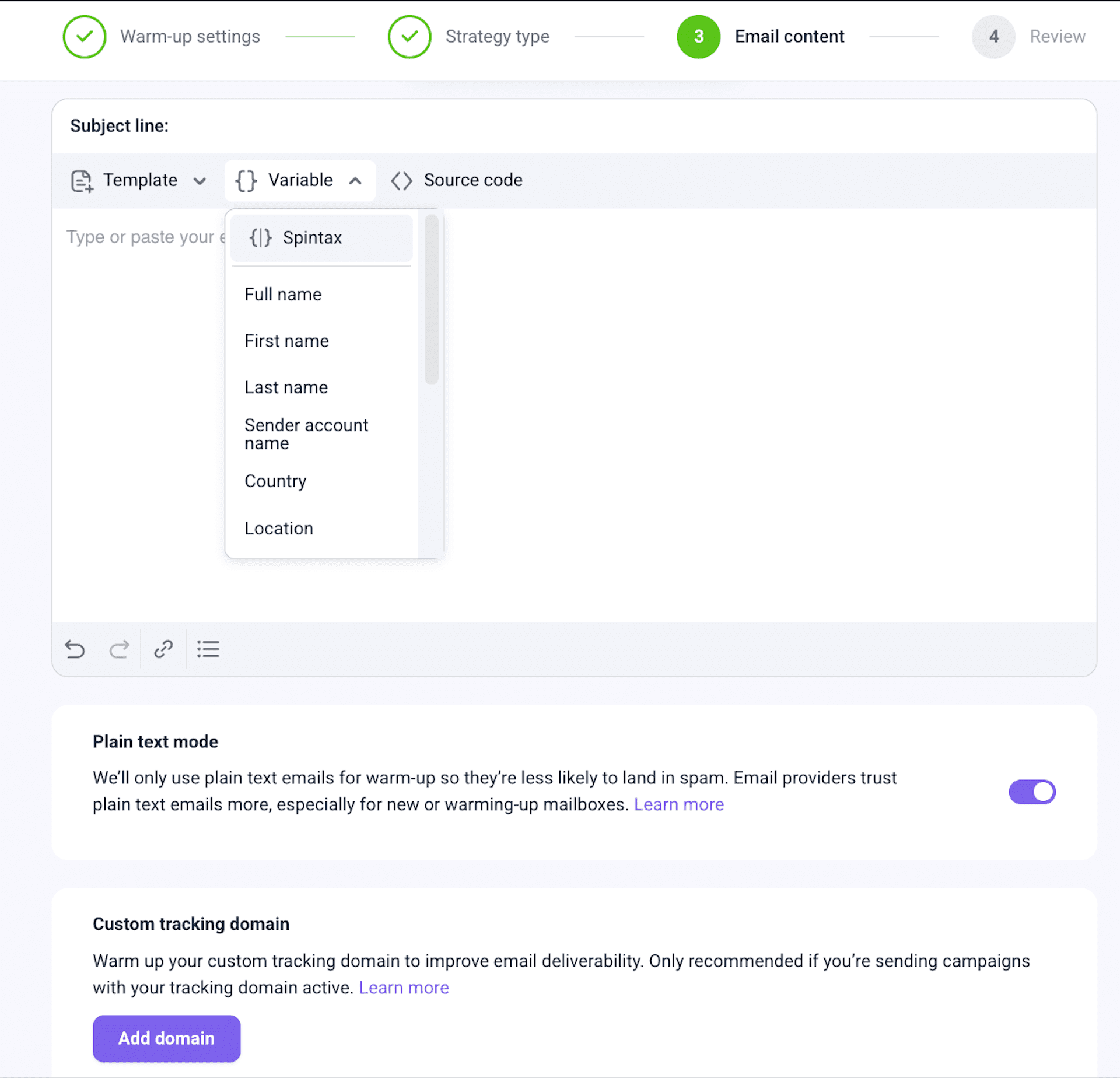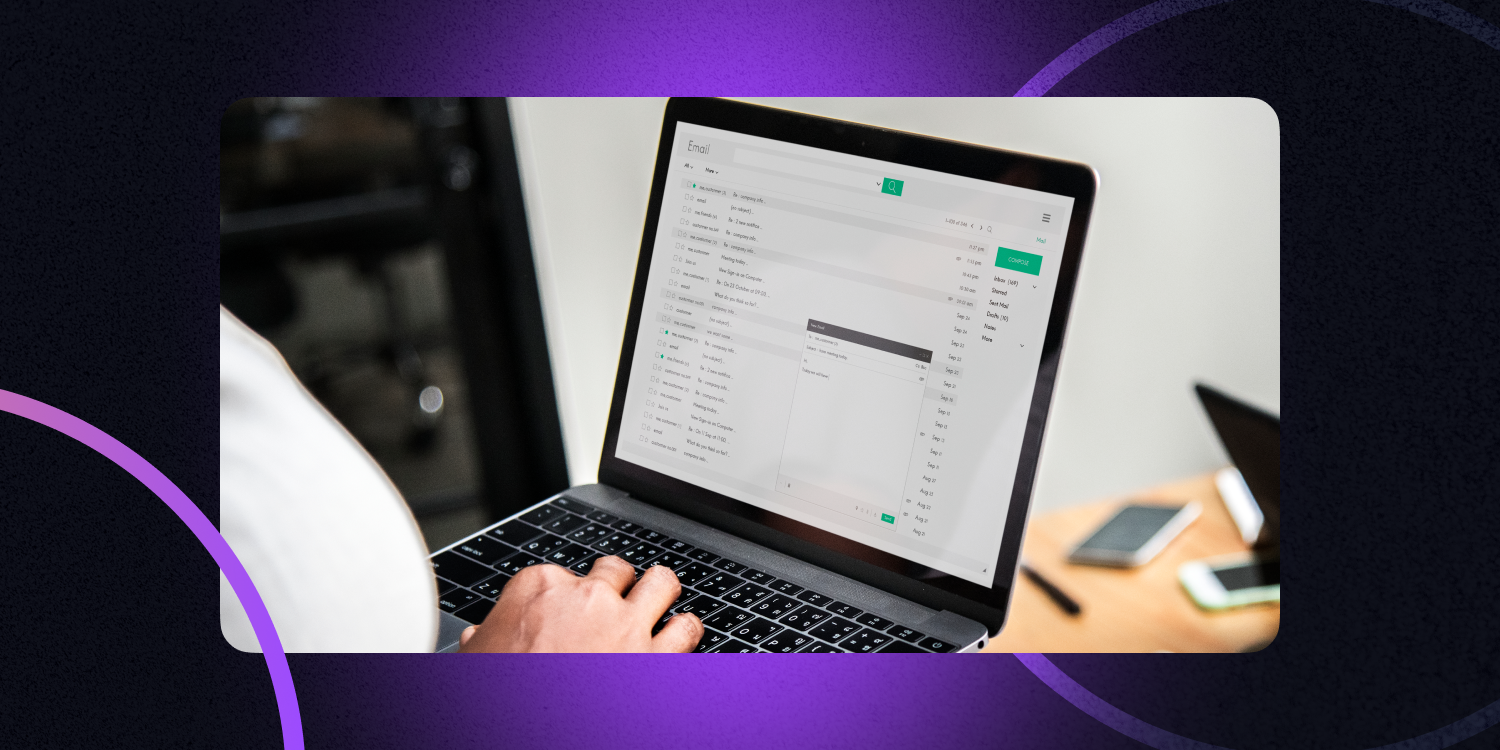TL;DR
What is email warm-up? That’s a gradual growth in outreach volume that helps establish trust with ESPs, so messages land in inboxes instead of spam folders.
Why is a warm-up necessary? Even with perfect subject lines and compelling content, accounts trigger spam filters, which often results in email deliverability issues. Email warm-up helps build or restore a sender reputation, maintaining a high inbox placement.
How to warm up an email? You can warm up an account manually or use automation tools like Snov.io for a fast, automatic, and low-effort process.
Email outreach is a lot like dating. Come on too strong and you risk turning people off or getting blocked altogether. The same goes for email service providers (ESPs): if you start blasting emails here and there, your messages might end up in spam folders soon.
That’s where email warm-up makes a difference, helping you build trust before initiating the full-on outreach. Read on to learn why warming up your account is so essential for email deliverability success, and how to do it effectively.
Key points of the article:
What is email warm-up?
Email warm-up is the process that consists in gradually increasing the account email volume with the aim of building a strong sender reputation with ESPs. It helps show that you’re a legitimate sender, not a spammer, so your messages are more likely to land in the inbox.
How email warm-up works
You start by sending a few messages a day to inboxes that will most likely open and respond to them. The goal is to reach a target sending volume without being flagged.
Day by day, you gradually increase the number of messages, allowing more people to start engaging with your campaigns. They open, respond, mark some emails as important, or move them out of spam. This signals to ESPs that you’re a real, trustworthy sender.
In a few weeks, you will increase the daily sending volume slightly again. And now, even more emails get delivered. Eventually, you reach your goal without hitting spam filters, your inbox placement grows, and you become ready for mass campaigns.
Benefits of email warm-up
Email warm-up is one of the simplest ways to set outreach campaigns up for success. Here are the key benefits it brings:
- Improved sender reputation and deliverability
Email accounts start with no reputation, which makes ESPs cautious. Gradually increasing email volume and generating steady, natural engagement helps build trust with providers like Gmail and Outlook. Over time, this strengthens your sender reputation.
A better reputation means more messages land in the inbox instead of the spam folder, giving you higher visibility and stronger campaign performance. Think of it as growing your credit score: better scores bring you higher email deliverability.
- Higher engagement
When your cold emails consistently reach the inbox, they’re more likely to get opened and answered. A warm-up helps drive better engagement by making your account appear more trustworthy to both ESPs and recipients.
This results in higher open rates, more meaningful responses, and more engaging conversations with the audience. Higher engagement leads to a stronger reputation and inbox placement. And the wheel keeps rolling.
- Protection from spam flags and blacklists
A warm-up provides your account with a smooth, natural sending history, characterized by low email bounce rates and minimal spam complaints. ESPs recognize it as a healthy sign, literally giving you a green light as a trustworthy sender.
As your messages now appear legitimate and desired, your account becomes more resilient, and email deliverability improves, ultimately leading to marketing success.
How do you know if your account needs a warm-up?
A warm-up is essential before launching any cold email outreach campaigns from a new account. As for old accounts, they might also require a warm-up if they display a dropped inbox placement rate.
Watch out for these common red flags:
- Low open rates – If no one’s opening your messages, they may not even see them.
- High email bounce rates – You’re hitting inactive or invalid addresses.
- Low reply rates – People aren’t engaging with your content.
If any of these sound familiar, it’s time to check your email health, which reflects how ESPs see your account.
This checkup includes testing email deliverability and spam rates to identify any hidden issues with your domain health and sender reputation. It can detect problems you might not notice in regular campaigns and help determine if a warm-up is necessary to improve inbox placement.

We recommend targeting these key benchmarks:
- Domain health score: 75-100%
- Spam rate: Below 2%
- Email placement: 90%+ inbox delivery
If your results fall below these standards, Snov.io will provide personalized recommendations to fix any issues and optimize the campaign performance. And yes, that will be the right moment to start warming up your account.
Manual vs. automated email warm-up
Before you learn exactly how to warm up an email account, keep in mind that there are two main ways to do this: manually or automatically by using automated tools. Both aim to build sender reputation and improve deliverability, but they differ in the amount of time, control, and technical effort that’s required.
Let’s discuss them in more detail.
What is a manual email warm-up?
Manual warm-up means handling every part of the process by yourself, from planning how many emails to send each day to writing and sending them.
Here’s what it involves:
- Creating a sending plan with a gradual volume increase.
- Manually writing messages that feel personal and encourage replies.
- Sending them to real contacts like colleagues, partners, or past leads who are likely to respond.
- Tracking metrics like open rates, replies, bounces, and spam complaints in spreadsheets or analytics tools.
- Adjusting daily sending volumes based on how your warm-up campaign performs.
You also need to build a trusted network of people who expect your messages and are willing to engage with them. These authentic interactions are the key signals that help improve an email reputation.
The upside? You have total visibility and control over every step. The downside? It’s slow and requires a lot of attention. With manual warm-up, it’s really easy to miss important red flags if you’re not monitoring closely.
What is an automated warm-up?
Automated email warm-up presupposes you’re handling all activities with the help of automated warm-up tools. These platforms simulate natural sending and engagement patterns on your behalf.
You just set the process, launch it, and enjoy the warm-up campaigns being sent automatically, with growing email deliverability rates.
The main benefit of automation? It’s fast, scalable, and consistent, reducing the chances of mistakes that could harm your reputation.
How to warm up an email account manually?
If you prefer to stay hands-on, prepare yourself for the following manual warm-up steps:
Step 1: Set up an email account
Start by creating a dedicated email account specifically for outreach. Whenever possible, use a domain that’s been active for some time instead of a brand-new one.
Make sure your name appears in the ‘From’ field, and set up a professional signature. Also, check that your account can receive emails from people outside your contact list.
Step 2: Authenticate your domain
Set up SPF, DKIM, and DMARC records to prove your emails are legitimate. Think of this as showing the ID card to ESPs so they know you’re not a spammer.
Step 3: Track engagement
Install a tool like the free Snov.io Email Tracker Chrome extension to see when people open your emails, click links, and reply. Watching these numbers tells you whether the warm-up is actually working.
Step 4: Subscribe to newsletters
Sign up for 10 to 15 newsletters from companies you actually find interesting. This creates natural activity in your inbox, which ESPs love to see.
Step 5: Start small by sending personal emails
Reach out to people you know, like coworkers, business partners, or friends. Ask them to open your messages, reply, and possibly forward them to someone else. But keep it all conversational, not salesy.
|
💡 Pro tip Blasting out tons of emails right away is the quickest way to land in spam or get an account blocked by your ESP. This is why timing email send-outs properly matters so much. Here’s an email schedule we recommend sticking to: Week 1: 5–10 per day Week 2: 10–20 per day Week 3: 25–50 per day Week 4: 50 per day |
Remember, slow and steady wins the race.
How to warm up an email account automatically?
Prefer a faster, easier way? Special warm-up software will take care of everything from volume ramp-up to engagement simulation, so you don’t have to do it all by yourself.
For example, such tools as Snov.io’s Email Warm-Up:
- Gradually ramp up the email volume using safe and proven patterns.
- Simulate engagement using smart algorithms that mimic real user behavior.
- Help repair sender reputation if you’re recovering from deliverability issues.
- Provide insights into spam rates, inbox placement statistics, and engagement levels, so you can track your progress in real-time.
Here’s how to warm up an email with Snov.io in just a few clicks:
Step 1: Choose your email account and settings
Head to the Email Warm-up page, select the account you want to warm up, and choose a preferred provider (e.g., Gmail, Hostinger, etc.).
Set your reply rate to around 30%, as this is ideal for building a strong sender reputation.
Here you can also set a warm-up schedule and even select a Premium pool of recipients so your campaign will target only professional business accounts.
Step 2: Pick a warm-up strategy
You can choose between two strategies: progressive or steady.
Progressive warm-up starts small and increases email volume daily — best for brand-new or inactive accounts.
Steady warm-up presupposes sending a consistent number of messages each day — ideal for stabilizing an account that has recently experienced deliverability issues.
Step 3: Add warm-up content
Here, you have different options:
- AI-powered
Generate lifelike messages with the help of AI for both warm-up emails and replies. This option makes it impossible for email providers to distinguish your warmup campaigns from real dialogues.
- Specific
Improve deliverability with your own email copy and use Spintax to increase the uniqueness of each email. You can also opt for plain text mode to reduce the likelihood of your emails landing in spam.
Last but not least, you can warm up your custom tracking domain to improve deliverability and minimize the risks of tracking.
Choose any option that suits your goals best.
Step 4: Launch and monitor
Once started, Snov.io handles all activity for you by simulating real interaction. The system will automatically send, open, reply to, and even move your messages out of spam folders. You’ll see emails with a “snv” label appear in your inbox.
You can filter messages with this label in a separate folder so it doesn’t distract your attention from other correspondence.
Don’t forget to track your Deliverability score in the dashboard. Once it reaches 90% or higher and your daily warm-up target is met, you’re ready to start your cold outreach.
How to choose email warm-up tools
When choosing a warm-up tool, certain features make the difference between a mediocre service and one that actually improves your deliverability.
Here’s what matters most:
Multi-provider support and targeted warm-up
Your warm-up tool should work with any ESP. This flexibility becomes crucial when you’re managing multiple accounts across different providers. Besides, look for tools that offer targeted warm-up options. You should be able to select specific providers for which you’ll be warming up your account.
Full automation
The best warm-up tools run on total autopilot once you start the process. With little manual intervention, your only task should be tracking the warm-up progress and checking how your inbox placement grows.
Multiple warm-up strategies
Warm-up tactics for newly created accounts and older accounts shouldn’t be the same. Your goals differ: in the first case, you gradually build trust and grow email deliverability, while in the second case, you restore your reputation as a sender. Therefore, focus on the tools that offer specific strategies for different objectives.
Customizable reply rates
This allows mimicking realistic behavior for your specific use case, ensuring that you don’t under- or over-do it. A result? You look more trustworthy in the eyes of ESPs, your campaigns never land in spam folders, and your deliverability rate grows steadily and consistently.
Premium sender pool options
Some tools offer you to exchange emails with professional business accounts, creating more realistic B2B communication patterns. By engaging with business domains, you produce a greater impact on your sender reputation.
Flexible content options
The tool should offer opportunities to use your own email templates or provide assistance in creating varied content with personalized copies.
Scheduling controls
Your warm-up schedule should align with the schedule you plan to use in real campaigns. The tool should let you set specific days of the week and hours when the warm-up is active. Outreach activity should be spread evenly throughout selected timeframes with random intervals between messages.
Detailed progress monitoring
One of the most important metrics to track is deliverability – the percentage of emails that reach the inbox during the warm-up period. Tools like Snov.io provide a breakdown by provider, allowing you to see results for specific email services and understand what deliverability to expect.
Choosing the right warm-up tool can make the difference between emails that reach the inbox and campaigns that fail before they start. Focus on the above-mentioned key features, and you’ll build a good foundation for your marketing success.
Common mistakes during the warm-up process
A warm-up is crucial for building a strong sender reputation, but doing it incorrectly can still harm your deliverability. Here are some common mistakes to avoid during the process:
❌ Sending too many emails too quickly. This can trigger spam filters, so start with a low volume and increase it gradually to build trust with inbox providers.
❌ Random sending patterns. Inconsistent warm-up kills your provider’s trust. Schedule your warm-up so you never miss a single day.
❌ Spammy or irrelevant content. Avoid salesy language, excessive images, or links in your warm-up email copies. Instead, focus on content that feels human, personal, and relevant.
❌ Ignoring the email authentication setup. Never skip setting SPF, DKIM, and DMARC for your outreach. Without these protocols, providers can’t verify your emails, which increases your chances of landing in spam folders.
❌ Overlooking key metrics. Monitor reply rates, bounces, and spam complaints (if any) during the warm-up period. Regularly track email deliverability improvement to understand whether the warm-up is effective.
❌ Treating warm-up as a one-time task. It’s not. Any time you launch a new campaign, switch domains, or recover from deliverability issues, you need to warm up again, especially if you’re using a new tool or strategy.
Key takeaways
Email warm-up goes beyond just being a technical step. It’s actually the foundation that makes your cold outreach successful.
You can warm up your account manually or automatically. Either way, the secret is staying consistent, keeping an eye on your results, and focusing on genuine engagement.
Ready to build a healthier email reputation without all the hassle? Try Snov.io’s automated warm-up to simplify the process while maintaining control over your deliverability.

